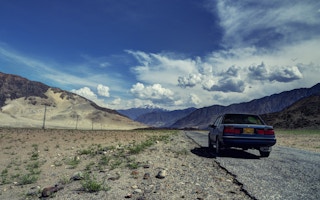It’s been a busy six months for China’s outward facing public investment.
In April, the Chinese-hosted BRICS’ New Development Bank (NDB), with its US$100 billion capitalisation, had its second annual meeting. In May, over 20 heads of state attended the launch of the Belt and Road Initiative, which will invest up to US$900 billion of land and sea-based infrastructure across Asia, Europe, Africa and Latin America. In July, the Asian Infrastructure Investment Bank (AIIB), with its initial capital of US$100 billion of investment, had its second annual meeting.
Many of these investments have been to counter a perceived Western bias in existing development investment, as well as address many developing countries’ infrastructure needs. For China, there’s the added advantage of increasing its political and economic power.
For some, this has benefits given China’s track record of reducing poverty and infrastructure investment. But others have concerns given China’s chequered domestic track record on local consultation and environmental management.
Do these investments demonstrate China’s growing commitment to an internationalist agenda of supporting the Sustainable Development Goals (SDGs) and implementing the Paris Agreement? Will they really reduce poverty and benefit the Least Developed Countries (LDCs)?
BRICS Bank—a go on green
Investment in the Shanghai-based BRICS’ New Development Bank has made environmental progress with massive lending for clean energy, including in South Africa and India, and issuing a green bond in China. In 2016, 80 per cent of the US$1.5 billion funds it lent were for renewable energy.
In fact, the NDB, in which China has a leading share of its contingency fund, has lent twice as much as the Green Climate Fund on climate mitigation with much less fanfare.
On poverty reduction, the results are more mixed. Although, it has partnered closely with the World Bank and other development banks, so far it has only focused investment in the BRICS emerging economies.
The projects are large, capital-intensive energy projects with limited focus on poverty reduction. Its main limitation is its constrained lending as an expansion requires equal financial contributions from each of its members, several of which, such as South Africa and Brazil, are in serious fiscal trouble.
Belt and Road Initiative’s mixed scorecard
China’s primary investment programme, the Belt and Road Initiative, will guide up to an estimated US$150 billion a year worth of Chinese investment over the medium term. Launched by President Xi in May, it combines a series of silk road economic corridors (the belt) with sea corridors (the maritime road).
It proposes to involve more than 60 countries, including massive infrastructure development programmes in Pakistan, an industrial port complex in Sri Lanka, and investments in Central Asia, Eastern Europe, Myanmar and Bangladesh.
China has set up several major funds to support this investment. Some look like they may promote poverty reduction through industrial development and could be environmentally beneficial through investments in renewables, railways and water resources management.
But others, such as the power and highway projects in Pakistan and Sri Lanka, continue the path of dirty development based on fossil fuels and road construction.
Asia Infrastructure Investment Bank: a development plus
Perhaps the most high-profile of China’s new investment vehicles, the AIIB, based in Beijing, now includes several Least Developed Countries.
Like the NDB, it seems keen to learn from existing development banks. In 2016, two-thirds of its projects were in partnership with the World Bank and other regional development banks building on their existing system for social and environmental safeguards.
But while poverty reduction is advancing the issue of the environment it is not fully prioritised in practice. Its limited environmental projects are outnumbered by such damaging projects as a fossil fuel natural gas plant in Myanmar and a highway project in Pakistan.
Its social and environmental safeguards have also been criticised for not adopting other multilateral development banks’ best practice. For example, regarding projects that affect indigenous peoples, rather than requiring free, prior and informed consent as is required by other such banks, it only requires free, prior, informed consultation for a loan. On pro-poor country selection, the picture is more positive, with one African and four Asian LDC members already, and more in the pipeline.
“
The process is just gearing up, but China’s outward public investment has huge potential for positive development and environment progress.
Why does this matter?
These investments matter. NDB and AIIB combined are equivalent in size to the World Bank—and they are likely to increase further while World Bank funding stagnates or declines, due to President Trump’s budget cuts. NDB lending on renewable energy is double the Green Climate Fund, though it gets less attention. And the Belt and Road Initiative may come to dwarf the US-funded Marshall Plan.
For the environment, the picture is mixed. While the NDB has a strong focus on the environment with an emphasis on renewables and commitment to “sustainable infrastructure”, Belt and Road and the AIIB seem more environmentally damaging as they focus on more traditional infrastructure.
On development, while some infrastructure may promote macro-economic growth, many of the borrowing countries have a poor track record on consulting local people.
AIIB already includes some LDCs and low income developing countries, and its portfolio includes a few more explicitly pro-poor projects such as slum and urban upgrading and urban mass transport. By contrast, the NDB is focused only on the emerging economies and on large-scale capital infrastructure energy projects.
The development impacts of the Belt and Road are more debatable, with key criteria for country selection and investment design being to support Chinese political and economic objectives rather than any overall drive to reduce poverty and achieve the SDGs.
Harnessing the huge potential
There is some progress which should appease initial critics. NDB and AIIB’s track record shows willing to partner and learn from existing multilateral development banks. There is potential for this to have strong development and environmental outcomes.
NDB is currently doing well on environment, while AIIB is doing better on poverty reduction. Both can learn from each other. But for real improvement, Chinese investment needs:
- A greater commitment to fund only sustainable investments that contribute to the Paris Agreement,
- A clear policy for public consultation and consent
- More LDC members and locate more projects there, and
- To ensure achieving the SDGs are explicit when identifying, designing, and monitoring and evaluation investment.
The process is just gearing up, but China’s outward public investment has huge potential for positive development and environment progress.
Paul Steele (paul.steele@iied.org) is IIED’s chief economist. This post is republished from the IIED blog.











